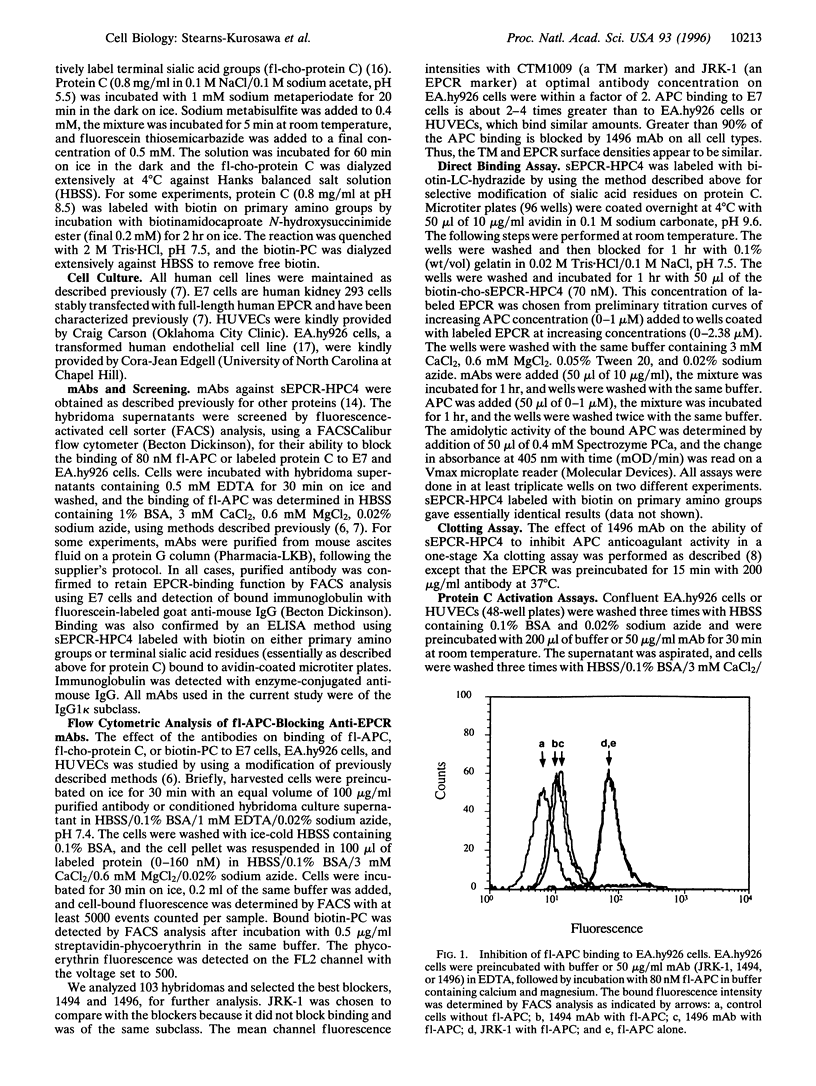Abstract
Protein C activation on the surface of the endothelium is critical to the negative regulation of blood coagulation. We now demonstrate that monoclonal antibodies that block protein C binding to the endothelial cell protein C receptor (EPCR) reduce protein C activation rates by the thrombin-thrombomodulin complex on endothelium, but that antibodies that bind to EPCR without blocking protein C binding have no effect. The kinetic result of blocking the EPCR-protein C interaction is an increased apparent Km for the activation without altering the affinity of thrombin for thrombomodulin. Activation rates of the protein C derivative lacking the gamma-carboxyglutamic acid domain, which is required for binding to EPCR, are not altered by the anti-EPCR antibodies. These data indicate that the protein C activation complex involves protein C, thrombin, thrombomodulin, and EPCR. These observations open new questions about the control of coagulation reactions on vascular endothelium.
Full text
PDF




Images in this article
Selected References
These references are in PubMed. This may not be the complete list of references from this article.
- Cheung W. F., Hamaguchi N., Smith K. J., Stafford D. W. The binding of human factor IX to endothelial cells is mediated by residues 3-11. J Biol Chem. 1992 Oct 15;267(29):20529–20531. [PubMed] [Google Scholar]
- Davie E. W., Fujikawa K., Kisiel W. The coagulation cascade: initiation, maintenance, and regulation. Biochemistry. 1991 Oct 29;30(43):10363–10370. doi: 10.1021/bi00107a001. [DOI] [PubMed] [Google Scholar]
- Edgell C. J., McDonald C. C., Graham J. B. Permanent cell line expressing human factor VIII-related antigen established by hybridization. Proc Natl Acad Sci U S A. 1983 Jun;80(12):3734–3737. doi: 10.1073/pnas.80.12.3734. [DOI] [PMC free article] [PubMed] [Google Scholar]
- Esmon C. T., Esmon N. L., Le Bonniec B. F., Johnson A. E. Protein C activation. Methods Enzymol. 1993;222:359–385. doi: 10.1016/0076-6879(93)22024-a. [DOI] [PubMed] [Google Scholar]
- Esmon C. T., Fukudome K. Cellular regulation of the protein C pathway. Semin Cell Biol. 1995 Oct;6(5):259–268. doi: 10.1006/scel.1995.0035. [DOI] [PubMed] [Google Scholar]
- Esmon N. L., DeBault L. E., Esmon C. T. Proteolytic formation and properties of gamma-carboxyglutamic acid-domainless protein C. J Biol Chem. 1983 May 10;258(9):5548–5553. [PubMed] [Google Scholar]
- Esmon N. L. Thrombomodulin. Semin Thromb Hemost. 1987 Oct;13(4):454–463. doi: 10.1055/s-2007-1003522. [DOI] [PubMed] [Google Scholar]
- Fukudome K., Esmon C. T. Identification, cloning, and regulation of a novel endothelial cell protein C/activated protein C receptor. J Biol Chem. 1994 Oct 21;269(42):26486–26491. [PubMed] [Google Scholar]
- Fukudome K., Kurosawa S., Stearns-Kurosawa D. J., He X., Rezaie A. R., Esmon C. T. The endothelial cell protein C receptor. Cell surface expression and direct ligand binding by the soluble receptor. J Biol Chem. 1996 Jul 19;271(29):17491–17498. doi: 10.1074/jbc.271.29.17491. [DOI] [PubMed] [Google Scholar]
- Healy A. M., Rayburn H. B., Rosenberg R. D., Weiler H. Absence of the blood-clotting regulator thrombomodulin causes embryonic lethality in mice before development of a functional cardiovascular system. Proc Natl Acad Sci U S A. 1995 Jan 31;92(3):850–854. doi: 10.1073/pnas.92.3.850. [DOI] [PMC free article] [PubMed] [Google Scholar]
- Kisiel W. Human plasma protein C: isolation, characterization, and mechanism of activation by alpha-thrombin. J Clin Invest. 1979 Sep;64(3):761–769. doi: 10.1172/JCI109521. [DOI] [PMC free article] [PubMed] [Google Scholar]
- O'Shannessy D. J., Quarles R. H. Labeling of the oligosaccharide moieties of immunoglobulins. J Immunol Methods. 1987 May 20;99(2):153–161. doi: 10.1016/0022-1759(87)90120-7. [DOI] [PubMed] [Google Scholar]
- Owen W. G., Esmon C. T., Jackson C. M. The conversion of prothrombin to thrombin. I. Characterization of the reaction products formed during the activation of bovine prothrombin. J Biol Chem. 1974 Jan 25;249(2):594–605. [PubMed] [Google Scholar]
- Regan L. M., Stearns-Kurosawa D. J., Kurosawa S., Mollica J., Fukudome K., Esmon C. T. The endothelial cell protein C receptor. Inhibition of activated protein C anticoagulant function without modulation of reaction with proteinase inhibitors. J Biol Chem. 1996 Jul 19;271(29):17499–17503. doi: 10.1074/jbc.271.29.17499. [DOI] [PubMed] [Google Scholar]
- Rezaie A. R., Cooper S. T., Church F. C., Esmon C. T. Protein C inhibitor is a potent inhibitor of the thrombin-thrombomodulin complex. J Biol Chem. 1995 Oct 27;270(43):25336–25339. doi: 10.1074/jbc.270.43.25336. [DOI] [PubMed] [Google Scholar]
- Rezaie A. R., Esmon C. T. The function of calcium in protein C activation by thrombin and the thrombin-thrombomodulin complex can be distinguished by mutational analysis of protein C derivatives. J Biol Chem. 1992 Dec 25;267(36):26104–26109. [PubMed] [Google Scholar]



